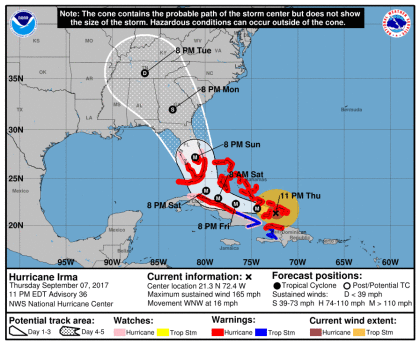Does Philadelphia Have to Fear Hurricane Irma?

Right now, most of my home state of Florida is on edge regarding Hurricane Irma, which is now the largest hurricane on record in the Atlantic. I hail from the Tampa Bay region, which (for now) is not looking like they’ll receive a direct hit, but things remain uncertain even as the storm crawls towards land and, inevitably, chaos and destruction. But what, if anything does Irma mean for the rest of the East Coast north of Florida – and, specifically, Philadelphia? That was the question posed by CBS Philly around midnight today.

This is, as of publication, the latest forecast for Hurricane Irma. It can and almost certainly will change, but no direct impact is expected for Philadelphia.
Here’s the good news, no waiting – it doesn’t look like Irma will do much of anything to Pennsylvania or Philadelphia. Right now the storm is swinging a wrecking ball through the Caribbean as the longest-tenured Category 5 hurricane on record, leaving wreckage, lost power, and downed trees in its wake. It is expected to have slowed some to a (still deadly) Category 4 storm before it makes landfall down at the tip of the Florida peninsula and weaken gradually as it makes its way up the middle of the state. That is as of right now, of course. All the hurricane projections in those spaghetti plots bank on Irma making a northern turn sometime early Saturday. At that point, the trajectory of her pivot will determine the fortune of Florida.
But here in Philly, we don’t have much to worry about. As it passes whatever part of Florida it lands on, Irma will quickly lose steam and downgrade to a tropical storm, followed by a tropical depression. There won’t be much left of her by the time her rain bands hit the Philly region Tuesday and Wednesday, bringing some showers and a bit of wind.
The fact that Irma will be making landfall in the U.S. on the heels of another major hurricane, Harvey, is history-making. The last time two hurricanes hit the U.S. was way back in 2004 with Ivan and Jeanne.



